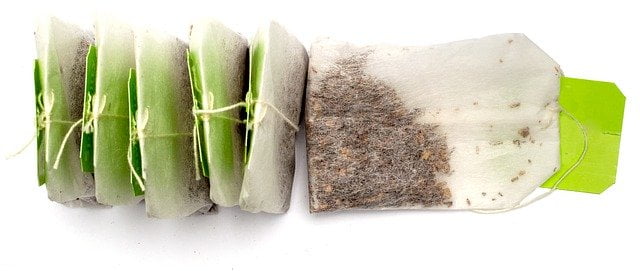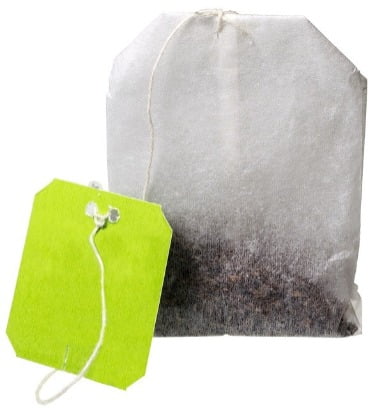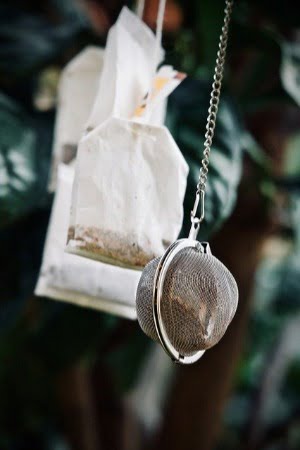Few people knowingly use plastic tea bags, which are a “Single Use Plastic“, and yet the fact is that most major tea brands don't use just paper. Read on and you will be amazed how tea bags are contributing to the plastic soup in our oceans and may even be jeopardising human health.
On This Page
- Don't Recycle Tea Bags – If You Care About the Damage Plastic is Doing to Nature
- Can You Recycle Tea Bags?
- Tea Bags Without Plastic
- Billions of Microparticles and Nanoparticles in Tea Made from Plastic Tea Bags
- Reusable Tea Bags – The Safe and Sustainable Alternative
- An Example of a Safe Sustainable Tea Business
- What you need to know about Microplastics
- Will You Take Plastic With Your Tea?
- What Kind of Plastic Is In Tea Bags?
- Plastic in Tea Bags: How to Overcome the Problem?
- How to avoid Plastic in Tea Bags?
- Conclusion
Don't Recycle Tea Bags – If You Care About the Damage Plastic is Doing to Nature
You might think tea bags are just simply paper and tea. They look like paper, so we all assume they decompose. Many of us like doing our bit by putting them in our home food waste to compost, but when drinking most top tea brands, we are wrong.
Unless the packet says they are plastic-free tea bags, they are not!
In actual fact, many of the teabags we buy use contain polypropylene and less often PET and polyester as the outer wrap material, so when you put the used bags in your food waste, you’re actually putting toxic chemicals into your beautiful compost. All these plastics are known to break up into microplastics that will eventually seep into the ground and be eaten, with the plastic potentially eventually entering human food.
Some plastic-free tea brands are not that green either. The products available differ between being biodegradable and compostable. It is important to know which. Without that knowledge, you can't dispose of your used tea bag correctly – and yet most brands don't tell you.
Can You Recycle Tea Bags?
Given what we have just revealed in this article, tea bags are not generally suitable for recycling via composting, now that we are all aware of the shocking damage plastics in oceans are causing. The exception is tea bags which, when bought are specifically marketed and labelled as plastic-free.

We predict that the big tea brands will all eventually go “plastic-free”, due to general public pressure to reduce plastic use. This will start to happen within the next 3 years throughout Europe and wherever governments have pledged to ban all but the most essential uses of single-use plastic. That will be a lot of nations within the next 5 to 10 years.
Meanwhile, there are plenty of other ways to recycle teabags. The most common is by re-soaking used tea bags for several hours. This produces tea-steeped water which contains some nutrients. It is good for watering plants. You may also break open the bag (throw the bag into your residual waste bin) and sprinkle the tea leaves around potted plants for a similar effect. Equally, the tea from inside the bag will help to grow-on young seedlings.
Think laterally and used tea bags can, reportedly, also be a great way to keep your glass and mirrors clean. Simply wipe the mirror or glass pane with a moist, used tea bag and dry with a soft cloth. natural skincare devotees also say that leftover tea can also be used to rehydrate your skin.
Tea Bags Without Plastic
There are already a number of tea brands which already offer tea bags without plastic. One such is Revolution Tea, with bio-degradable tea bags (London – Beware: Website hacked when visited on publication date and may no longer be trading). They seem to be “ahead of the curve” in appreciating the positive impact plastic-free tea bags can have on the environment. Their products are organic teas specifically made with eco-friendly tea bags in mind. Their marketing material states that users never have to worry about where their tea bag will go after consumption anymore. A word of caution here though as some “bio-degradable” tea bags are only, in fact, bio-degradable if returned to the manufacturer and bio-degraded in a special commercial composting process.
At this point, this article moves from a concern about nature to a real concern about the effect that plastic tea bags may be having on tea drinkers, and we quote:
Tea drinkers have been urged to avoid plastic tea bags after tests found that a single bag sheds billions of particles of microplastic into each cup. A Canadian team found that steeping a plastic tea bag at a brewing temperature of 95°c releases around 11. 6 billion microplastics – tiny pieces of plastic between 100 nanometres and 5 millimetres in size – into a single cup. That is several orders of magnitude higher than other foods and drinks.
“We think that it is a lot when compared to other foods that contain microplastics,”
says Nathalie Tufenkji at McGill University.
“table salt, which has a relatively high microplastic content, has been reported to contain approximately 0. 005 micrograms plastic per gram salt. A cup of tea contains thousands of times greater mass of plastic, at 16 micrograms per cup”.
A look at the paper shows small water creatures which were shown to show negative effects on their development when subjected to cold tea made from plastic tea bags. It seems surprising to say the least that the scientific community has not been bringing alarm bells of concern about these microplastics in the human tea drinker's diet, given the evidence in this paper.
It has to be said that for the person who decides to make a buying decision to avoid plastic tea bags it's still more complicated than you would expect.
We have read that some companies, use oil-based plastics, which are not advised for use in compost. However, other tea companies, such as Clipper, use plant-based plastics and even claim that these are not plastic. That’s controversial, with one study by the University College of London claiming that biodegradable ‘compostable’ bags can still be intact three years after being buried in the ground.
That’s apparently not a unique experience either. We've seen comments to the effect that people have tried putting food waste in biodegradable bags specifically designed for food waste in their composting bins. When, often many weeks later, they would expect to see no more than a brown fibrous compost these bags are still intact. It is clear that the manufacturer's definition of compostable can be a mile different from what a person well-used to composting their food waste might expect.
Billions of Microparticles and Nanoparticles in Tea Made from Plastic Tea Bags
We thought that we would include more detail from the recent research quoted above, which was published in September 2019.
Tufenkji’s team bought four different tea bags from shops and cafés in Montreal, cut them open and washed them, steeped them in 95°C water and analysed the water with electron microscopes and spectroscopy. A control of uncut tea bags was used to check it wasn’t the cutting that was causing the leaching of microplastics. To test the potential toxicity of the particles released by plastic tea bags, Tufenkji and her colleagues exposed water fleas to the contaminated water. The results showed an impact on those little creatures.
While microplastics are increasingly found in drinking water, the world health organization maintains that there is no evidence of a health risk for humans. No evidence does not mean “No Risk” and we will await more evidence before we conclude that plastic tea bags are safe to humans.
Fortunately, there are already several brands available in the UK, that have gone ahead and have eliminated all plastic from their bags. These include:
- Abel & Cole Clipper
- Co-op own brand 99
- Pukka Herbs Teapigs
- Brew Tea Company.
(Note: If planning a buying decision you must check with each company yourself as specifications change and by the time you read this additional companies may also be offering plastic-free tea bags.)
Reusable Tea Bags – The Safe and Sustainable Alternative
 Assuming that after reading this article so far, you've considered avoiding tea-drinking altogether, but as you love your cuppa you are wondering about alternatives. Loose leaf tea is an option but usually ends up producing a certain amount of mess. You could use coffee filters made out of recycled paper. Seek out the type that you can fold or twist around a spoonful of loose-leaf tea, or maybe you could even sew your own simple bags out of cheesecloth.
Assuming that after reading this article so far, you've considered avoiding tea-drinking altogether, but as you love your cuppa you are wondering about alternatives. Loose leaf tea is an option but usually ends up producing a certain amount of mess. You could use coffee filters made out of recycled paper. Seek out the type that you can fold or twist around a spoonful of loose-leaf tea, or maybe you could even sew your own simple bags out of cheesecloth.
A better option is to buy reusable tea bags, and as there are a few things you should think about before making a final decision we recommend a visit to the ecofreek.com website. They have compared a full range of reusable tea bag products made from a range of materials including Cotton, Stainless Steel, and Silicone to make your choice easy.
An Example of a Safe Sustainable Tea Business
So far we have looked at your favourite cuppa and why you should think about not using plastic tea bags due to microplastics leaching in water. However, we have not so far considered the outer tea packaging and we should as this is also important to any purchasing decision.
Packets of tea come in different materials including paper, plastic and silk (we are reliably informed). Even when tea bags are made from paper, they may also contain a small amount of plastic in the glue used to seal them shut. As we have already mentioned, premium brands have switched to using greater amounts of plastic mesh over the years for their products instead. Worse still is that added plastic is rarely mentioned on the packaging, and so the consumer remains blissfully unaware. Plastic tea bags are another worrying way for microplastics to end up in the environment, and also in your human body, and this is happening without the tea-drinkers’ knowledge.
The “Brew Tea Company” brand is about as transparent and sustainable as they come. Brew Tea is a company based in Manchester, UK. It uses whole leaves (not dust, it says, and so they should because this is pricey tea even for English Breakfast blends) and is a member of the ethical tea partnership which supports small estate growers. This is reportedly a refreshing brew full of flavour. All the tea bags from the brand are made from cornstarch, the inner lining is made from nature-flex and inside the box is a really useful card telling you what all the packing is made from and how it should be recycled. The tea bags and inner lining should be placed in your food waste caddy for council food recycling. This material decomposes in about 45 days. The outer box goes into paper recycling.
What you need to know about Microplastics
Returning to the issue of microplastics found in Canadian research. For tea drinkers, this is an alarming study. The researchers did not reveal which brands they had used in the study, but suggested that rather than avoiding brands consumers should try to avoid plastic packaging and consider switching to loose teas or paper teabags. Most ‘ordinary’ plastic bags may look like they’re just made of paper but are held together with a sealant that contains polypropylene. This means if composted, they could still technically leave microplastics in the soil. Abel & Cole and Teapigs report using plant-based Soilon and Clipper make a plastic-free teabag made from bananas, while some Tetley and Twinings ranges are biodegradable. (Tetley now (August 2020) states in their FAQs that; “Tetley tea bags do contain a very small amount of plastic to ensure the bags remain closed for you to enjoy your cup of tea, and that they are 99% bio-degradable.)
Microplastics are not uniquely found in tea brewed in plastic tea bags. Increasingly they are building up in our environment and are present in tap and bottled waters, and in some foods that we eat such as sea salt. So much so, that some people are asking whether it is useless to even try to eliminate the ingestion of microplastics anymore. They are everywhere, in our drinking water, in the soil, in fish and animals. And now us.
Will You Take Plastic With Your Tea?
 O.K. That statement is a bit extreme, but as we continue in ever more detail to consider plastics in tea bags we will again revisit the Canadian research:
O.K. That statement is a bit extreme, but as we continue in ever more detail to consider plastics in tea bags we will again revisit the Canadian research:
“the particles did not kill the water fleas, but did cause significant behavioural effects and developmental malformations,”
Tufenkji says. However, she says that more research is needed to understand possible health impacts on humans. In the meantime, Tufenkji suggests new scientist readers avoid plastic tea bags.
“tea can be purchased in paper tea bags or as loose-leaf tea, which eliminates the need for this single-use plastic packaging. ”
(Journal reference: Environmental Science & Technology, DOI: 10. 1021/acs. Est. 9b02540)
We have to conclude that tea leaves are a good addition to the compost heap. However, tea bags are not. All organisations which provide advice on what is compatible and what is not should update their advice on composting tea bags, with the knowledge that most bags include very small amounts of plastic. Many makes of tea bags, even the organic brands, often include a small amount of polypropylene, which helps with the sealing and tying of the bag.
This will not break down in the domestic compost heap, and indeed particles will remain even after commercial ‘green waste' composting. Some brands use instead a polymer fibre derived from plant starch, called PLA. In the US, this starch is often sourced from genetically engineered crops. This will eventually degrade in the home compost heap, but it takes some time.
What Kind of Plastic Is In Tea Bags?
Oil-based plastics used in tea bags which have been revealed by suppliers include polypropylene (also popularly known as nylon), polyester, and PET. A full list is not known.
Pukka herbs tea bags are free of plastic, tied together with organic cotton and are fully compostable. On their website, they say:
“Pukka doesn’t use this kind of material. Instead, we use a simple stitch of organic cotton and a unique folding process. This means we don’t need to use polypropylene to hold our teabags together and our teabags are therefore free from plastic.”
They say that they were the first company to ever use organic strings to hold our teabags together without the need for a metal staple or polypropylene.
Clipper teas, the tea brand owned by natural and organic food company Wessanen UK, has introduced new fully recyclable tea bag envelopes. Image: clipper teas has introduced new recyclable tea bag envelopes. As part of its sustainable efforts, clipper now provides a fully recyclable tea bag envelope and 100% organic string on its string and tag tea bags. Last year, the tea brand launched plastic-free, unbleached and non-gm tea bag, which is claimed to be the world’s first kind of this product type.
Plastic in Tea Bags: How to Overcome the Problem?
 Unfortunately, plastic-free paper tea bags aren’t necessarily completely safe. Paper tea bags are often bleached to give them a clean white look which is considered more visually appealing than their natural colour, which is a light brown. The bleaching process usually involves using epichlorohydrin or dioxins. Epichlorohydrin is a chemical made using chlorine that is also used as a pesticide, while dioxins are toxic chemicals that can cause cancer, among other health problems. The levels remaining in tea bags after the bleaching process probably isn’t enough to do much damage, but you might prefer to opt for unbleached tea bags instead.
Unfortunately, plastic-free paper tea bags aren’t necessarily completely safe. Paper tea bags are often bleached to give them a clean white look which is considered more visually appealing than their natural colour, which is a light brown. The bleaching process usually involves using epichlorohydrin or dioxins. Epichlorohydrin is a chemical made using chlorine that is also used as a pesticide, while dioxins are toxic chemicals that can cause cancer, among other health problems. The levels remaining in tea bags after the bleaching process probably isn’t enough to do much damage, but you might prefer to opt for unbleached tea bags instead.
The term “bio-plastic” causes confusion, according to UK Government organisation WRAP, but it simply means the plastic does not come from a fossil-based source. The sustainability campaign group says it needs to be separated from the word “compostable” because bio-plastics and oil-based plastics can both be compostable. The key difference is bio-plastic comes from a renewable resource. Under the UK plastics pact, which is being led by WRAP, the focus has been on urging companies to switch to compostable materials for teabags. The pact says teabags containing plastic are problematic because they can contaminate compost when they are recycled with food waste. often consumers don't realise they have plastic in them.
The UK Plastics Pact was published in February 2020. It provides new guidance to help businesses make informed choices when considering the use of compostable packaging. It also should help to ensure that the term is used while also explaining whether the material is home compostable or requires a sophisticated commercial process.
How to avoid Plastic in Tea Bags?
Avoid bags that contain plastic or synthetic fibres. Look for tea bags that are labelled certified home compostable. If you are unsure whether your tea bag is compostable, test one in a good composting system such as a bokashi composter. Simply add the tea bag to your bokashi composter with the rest of your food waste. Bury the bokashi pre-compost (including the tea bag) as normal. Check back in 2 to 4 weeks and if the skeleton of the tea bag is still visible the tea bag is not compostable and likely contains plastics.
Conclusion
An estimated 165 million cups of tea are drunk in the UK every day and 96% of those are made using a bag. Tea is one of the most popular drinks in the UK, however, many were shocked to hear that the humble (but useful) teabag often contains plastic. Given that tea bags are arguably an avoidable type of food waste, a growing question is what can we do with these tea bags once they’ve been used. This poses the still open question for most popular tea brands of can they be composted or should we throw them away?
Most people use teabags as they are convenient. However, most plastics used in them are not eco-friendly. Such teabags are not suitable for your health either. There are much healthier and convenient alternatives available in the market. The following are the most popular and secure alternatives to using plastic tea bags that you can consider:
- the simplest way to avoid plastic in tea bags is to use loose tea. Most people avoid using loose tea leaves as they consider it difficult to use. You can get used to it, avoid making a mess/ spilling the tea leaves, and may even find it a better flavour than your regular teabag.
Loose tea leaves are considered a better product as they are not ground fine to fit into a small teabag. Generally, buying loose tea is cheaper than teabags. It's even less expensive if you buy it in bulk. Using loose tea leaves not only helps you save money. You will also contribute to protecting the environment by avoiding plastic in tea bags.
Brewing a cup of excellent tea using loose tea leaves is convenient. Put loose tea leaves in your teacup. Boil water and pour it into the teacup containing loose tea leaves. But, if you are reluctant to do that use a tea strainer, tea egg, tea ball, reusable tea bag, tea infuser, or a teapot filter (all of which are available at Ecofreek.com.)
Finally, do remember to keep an eye out for hidden plastic, it is really surprising just how many things are made of the stuff. Even in simple things like tea bags, plastic is everywhere. Use loose-leaf tea and that problem is solved, the leftover tea leaves make great compost for your garden.






Have you ever thought about writing an article about the same issues and coffee filters. How compostable are they, for example.
Thanks for identifying plastic tea bags provide a way to various diseases. Companies should look forward further to providing tea inside a more natural thing. They must stop always competing to be cheapest today and tomorrow and THINK about the day after tomorrow.
There is a ton of useful information in this article. I loved the witty writing style. I also found some useful information here https://conservationconstructionofdallas.com/. Keep up the good work and I will check back later for other articles.
Salut, how are you all? I believe everyone is gaining something from your blog, and your views are helpful to brand new visitors. This one for example makes me think about pollution from drinking the tea.